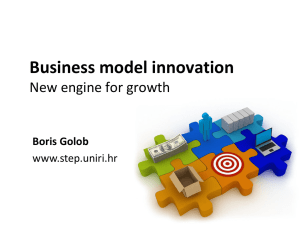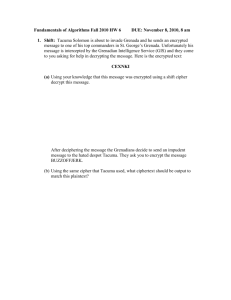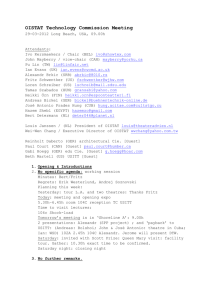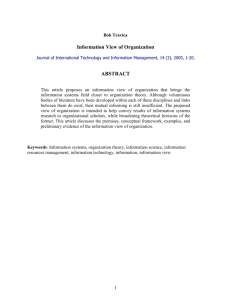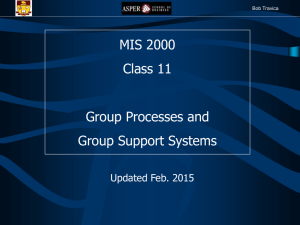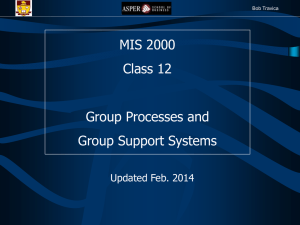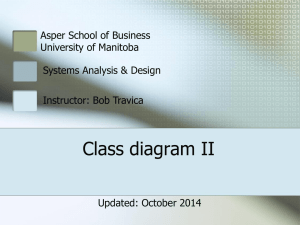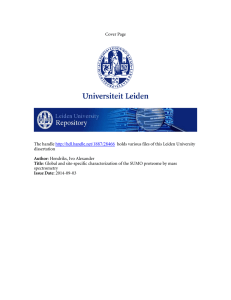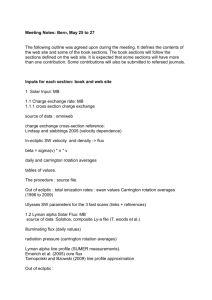Shorter description - University of Manitoba
advertisement
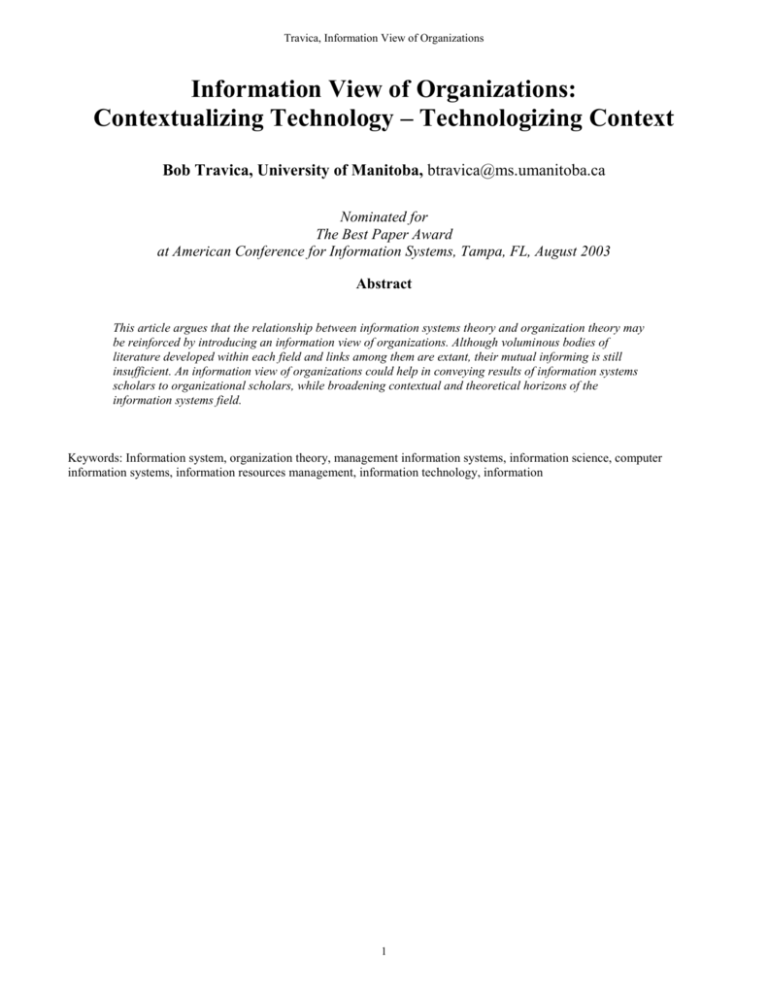
Travica, Information View of Organizations Information View of Organizations: Contextualizing Technology – Technologizing Context Bob Travica, University of Manitoba, btravica@ms.umanitoba.ca Nominated for The Best Paper Award at American Conference for Information Systems, Tampa, FL, August 2003 Abstract This article argues that the relationship between information systems theory and organization theory may be reinforced by introducing an information view of organizations. Although voluminous bodies of literature developed within each field and links among them are extant, their mutual informing is still insufficient. An information view of organizations could help in conveying results of information systems scholars to organizational scholars, while broadening contextual and theoretical horizons of the information systems field. Keywords: Information system, organization theory, management information systems, information science, computer information systems, information resources management, information technology, information 1 Travica, Information View of Organizations Introduction The purpose of this article is to propose an information view of organizations (IVO) that can reinforce the relationship and increase exchanges between organization theory and the field of information systems (IS). Organization theory (or field, research) is used here as an umbrella term, which refers to study of organizations that takes various perspectives (e.g., structure, culture, economics, management, etc.), is instantiated in various theories and frameworks (e.g., institutional theory, resource dependence theory, and transaction cost theory), and is rooted in different ontologies and epistemologies (e.g., functionalist, and interpretive approaches). Organization theory is labeled in various ways, including sociology of organizations, management theory, organizational behavior, micro economics, etc. The IS field (or theory, research) refers to study of IS, information and information technology (IT) (separately or as components of IS) and the people associated with these artifacts (the users). Information is taken in a broader sense to mean knowledge, information in a narrow sense (meaningful data in context), data (symbols with some generic or no particular meaning) and wisdom (the ability of making a right judgment). IS research is occupied with different types of ISes; e.g., those for decision making (DSS), groupwork (GSS), and enterprise resource planning (ERP). The standard issues include adoption, management, use, value, and design. IS research also deals with information (e.g., organization of it, digital documents properties and effects, and information-related behavior), various frameworks (e.g., electronic commerce and knowledge management), and applications of particular theories (e.g., the theory of task-technology fit). IS theory can also be traced to different ontologies and epistemologies, and it bears various labels, including information systems, management information systems, information science or study, information resources management, and computer information systems. It will be argued in this article that the cross-pollination between the systems and organization theory is still insufficient (cf. Orlikowski & Barley, 2001), although links between them have existed for decades. An IVO will be offered as a possible solution that would introduce an integrated IS view into organization theory as well as broaden the horizon of IS theory. It is to be noted that this is a programmatic article with the purpose of initiating the public discussion rather than providing exhaustive and definitive answers. This fact adds to the space limitation to result in an incomplete selection of authors and titles. Narrow bridge The relationship between IS theory and organization theory can be traced back to the mid 20th century. At the outset, they share a parent – general and special systems theory (see Figure 1). General systems theory provided foundations for thinking about information, IT and IS. Any type of IS and a specific instance of it embody the core concepts of general systems theory. Its special extensions advanced understanding, for example, of systems’ self-regulation (Wiener, 1948), and telecommunications systems (Shannon and Weaver, 1949). These foundations are still visible in IS theory. A similar lineage, albeit somewhat less impacting, could be traced in organization theory. The father of general systems theory Ludwig von Bertalanffy (1968) included organization theory in his selection of relevant disciplines. The impact of systems theory on organizational theory was recognized early on (e.g., Scott, 1963). James March (1965) included an extensive chapter on elements of a systems view of organizations in his representative selection of organization theory. The chapter’s author asserted that the power of systems theory for organization and management was beginning to be appreciated (Haberstroth, 1965: 1172). In later developments, systems theory yielded outcomes relevant both for the organization and IS fields (e.g., Galbraith, 1973; Lawrence & Lorsch, 1967; Scott, 1981; Thompson, 1967). Exchanges between organization theory and IS theory represent another aspect of their relationship (Figure 1). Haberstroth’s work (1965) mentioned above touches on IS (labeled with “informational systems” in the book’s index), and qualifies them as “one of the more important properties of the organization” (p. 1192). In the most recent review of organizational literature edited by Stewart Clegg et al. (1996), IS-related issues cover even more space. Relevant chapters deal with “group information technology,” decision making, cognitions in organizations, communication, organizational learning, and technology. The subject index contains seven references to information, six to IT, 32 to knowledge, and a chapter on GSS. Weick’s (1990) concept of technology as equivoque is yet another example of organizational scholars’ interest in issues relevant for the IS field. 2 Travica, Information View of Organizations IS scholars, on the other hand, have been building on organization theory. The sociotechnical approach to IT has a long history. Another venue is characterized by focusing on specific organizational processes or aspects in conjunction with relevant IT/IS. Examples include decision making and DSSes, computer mediated communication and IT for electronic communication (Hiltz & Turoff, 1978; Rice, 1984; Sproul & Kiesler, 1991), groupwork and GSS (e.g., Ciborra et al., 1996; Galagher et al., 1990; Nunamaker, 1997), and organizational processes and structures in relation with ERP systems. Specific organizational views have been used as well (e.g., the structural and cultural). Moreover, the IS field took a special interest in the theme of new organizational designs. Study of these was initiated within organization theory (e.g, Burns & Stalker, 1961; Handy, 1989; Mintzberg, 1979) and it expanded with the interest in new types of IT and organizational changes since the 1980s (e.g., Heckscher & Donnellon, 1994; Morton, 1991; Sproul & Kiesler, 1991). A paramount example is the topic of virtual organization (Davidow & Malone, 1992; Mowshowitz, 1994, 2002), indicating that IS research can sometimes advance over organization theory because it is driven with the latest developments in IT/IS. In addition, particular organizational theories have attracted attention of IS researchers, including transactions costs theory, resource dependence theory, and institutional theory. In this domain IS theory also demonstrates certain agility: Anthony Giddens’s theory of social structure (structuration theory) was adopted in the IS field directly from sociology rather than from organization theory (cf. Jones; 1999; Hatch, 1997). It is to be noted that one of the characteristics of IS research is an orientation on practical management issues rather than theory building. The relationship between organization theory and the IS field has also been maintained through interdisciplinary research that bridges them. A good historical example is Herbert Simon’s work that was evolving around both organizations and IS. There have been organizational researchers with interest in IT and information issues (e.g., Jay Galbraith and Karl Weick), and IS researchers with interest in organization theory (e.g., Lynne Markus and Wanda Orlikowski). Another level of this bridging refers to certain topical areas that are shared across the two fields, such as, organizational learning and knowledge management. Few publishing outlets also work on bridging the fields; an example is the journal Organization Science. Although the multi-facetted relationship between the fields of organization theory and IS does exist, the cross-pollination between the two fields is still insufficient. Due to various reasons, an intra-disciplinary focus is the rule rather than exception. The number of researchers with interest in both fields has been small, and the evidence on the lack of exchanges between the two fields is abundant. Given the pervasiveness of IT in contemporary organizations, study of it still takes a smaller proportion in organization theory. The topic of e-commerce, which excites so many IS researchers, is almost unknown among organizational scholars. A search of well-known publishing outlets, including Organization Science, Organization Studies, and Administrative Science Quarterly returned just a few references on e-commerce in the past five years. In contrast, the topic is visible in IS journals (e.g., MIS Quarterly, and Communications of the ACM) and some are exclusively dedicated to it. Moreover, IT poses as just one of technologies (a “high technology”) in organization theory. The line of studying organizational technology that connects Joan Woodward, James Thompson, Jay Galbraith, Charles Perrow and Karl Weick (see Hatch, 1997) may just partially be relevant to contemporary digital IT. For example, it could be argued that different kinds of IT could fit into any of the typologies of technology these researchers developed. If so, the typologies do not account for IT types. At the same time, today’s IT is more complex than other technologies of the past and it has yet unexplained characteristics. (Galbraith (1973) and Weick (1990) have come closer to an IT-relevant perspective than others cited.) Given this abstract approach to technology, it is not peculiar that differences, say, between communication, decision and enterprisewide IT/IS do not even come close to the radar screen of organization theory. An implication is the magnification of the problem of de-technologized context. The IS field bears its part of responsibility for a narrow bridge connecting it with organization theory. Some parts of the IS field appear to be disconnected from organization theory (or some other context relevant for the information perspective; e.g., the cognitive one). They tend to deal merely with describing capabilities of trendy IT and possible implications for organizations or with measuring/correlating some aspects of IT/IS with behavioral and organizational aspects. Similarly, information-focused study (e.g., research on information seeking and creation) is usually focused on the individual who is either isolated or just loosely connected with some environment. Purely technical research influenced by applied computer science suffers even more from the problem of de-contextualization. As a result, IS research sometimes discovers the ephemeral or the obvious. Moreover, most of the IS field keeps to traditionalistic philosophies (functionalism, structural functionalism), while missing the opportunity to approach IT and information issues from more diverse perspectives (e.g., the interpretive and postmodern). As today’s IS use many operating systems in complex, distributed, boundary-less architectures, IS researchers may benefit from expanding the thinking of organizations beyond the metaphor of machine. Communicating over the narrow bridge appears to be unsatisfactory for both the IS and organization theory. Broadening the bridge could help organization theory get an insight into the newest types of IT and information-related phenomena in organizations. From the perspective of the IS field, organizations are a natural habitat for IT, information and IS (even though not the exclusive one). Therefore, a broader opening toward organization theory may help to obtain a potentially larger theoretical horizon and relevance. 3 Travica, Information View of Organizations Scope of IVO The IVO is supposed to broaden the narrow bridge between the IS filed and organization theory. The following discussion outlines an initial sketch of its possible scope of study. Individuals and groups Individuals make a logical beginning of IVO because an organization, no matter how we conceive it, is still a collection of individuals. Indeed, early research that operated on the bridge between IS and organization theory introduced the individual perspective (March & Simon, 1958). From the IVO perspective, individuals are information creators, processors, disseminators, and users. Cognitive psychology can be instrumental in understanding perception, memory and retrieval, thinking, knowledge and other information-related dimensions (e.g., Eysenck & Keane, 1995). Electronic information can be associated with specific information behaviors (e.g., Dillon, 1994). In addition, information in a narrow sense and knowledge can be subjective in character. This impacts on some important organizational phenomena, such as, decision making and communication. In order to conceive this, one needs suitable ontologies that view organizations not only as the places populated by individuals but also as entities that are being created by individuals (cf. Weick, 1969). An example of such approach is the interpretive paradigm (see Czarniawska-Joerges, 1992). Organizational members are also users of IT. This is the area in which IT theory has made significant contributions from early adoption studies to modern research on mental models and structuration processes. Users of IT in today’s organizations can indeed be creators of IT. This unorthodox practice has a theoretical background in participatory design and other innovations in methodologies for developing IS coming from the Scandinavian tradition (see Iivari & Lyytinen, 1999). All these aspects can be relevant for IVO. Organizations are also collection of groups. Or put another way, work groups (teams, committees, etc.) can make an important organizing unit in organizations. This has always been a case in the matrix organization in various industries, such as, mining (Tavistock studies), airplane manufacturing (Galbraith, 1973), and public accounting (Travica, 1999). Since the early 1980s, the theme of groupwork began to be shared throughout the world or organizations. Groups may have thier particular perception, information processing, thinking, and memorizing dimensions, as speculated by early social psychologists. Knowledge and information in a narrow sense obtain a new meaning in the group context to refer to a pattern of connections across individual members. GSSes that facilitate communication and collaboration in groups have been the subject of intensive study for years. Groups can also shape the relationship between IT and people by compensating for the narrow bandwidth of communication technology (as exemplified in the revision of media richness theory) and for limitations of a spatially dispersed work design (Majchrzak et al., 2000). All these issues are important for IVO, since they concern both IS and organizational researchers (e.g., Shulman, 1996). The IS field offers significant contributions in this respect. “Organizational views” revisited One way to bring closer theories on IS and on organizations is by refocusing analytical lenses in order to demonstrate that the information/IT-related content has always been part of important organizational aspects even though this has not been recognized. Information in a broader sense and IT (including its pre-electronic kinds) have been embedded in organizational structure, culture, politics, and so on. To illustrate. The structural dimension of hierarchy, defined by classicists as the levels of graded authority (Weber, 1946), can also be understood in terms of the levels or vertical distribution of information and IT. Links between hierarchy, IT and information have already been studied (Zuboff, 1988). Indeed, one can argue that hierarchy is based on the asymmetric possession of data and information in a narrow sense and asymmetric access to knowledge and IT. This possession and access could be understood as constituents of a hierarchical level. It is interesting that the mere accumulation of information rather than the extent of using it is likely to be an indication of a higher level of authority. This brings IT into play again, this time as a report mill that reinforces hierarchy. On the other hand, IT can be instrumental in reducing the middle management. In any case, the vertical distribution of information and IT complements the classical notion of hierarchy. Similar “twists” can be applied to centralization, departmentalization, and other structural dimensions. The revision is more than a cosmetic change. It is dictated by our time in which information becomes the main work matter and electronic IT is the core technology. Not only is this IT the prevailing, essential part of transforming organizational inputs into outputs, but it also provides the foundation to organizational designs. In other words, informationrelated aspects have become important in explaining organizational structure and other organizational aspects. To be sure, 4 Travica, Information View of Organizations this thesis does not imply that the problem of organizational change can be reduced to IT and information; rather, these aspects are as important as others implied in the classical Leavitt’s model of organization (and its iterations), and the aspects’ concurrent changes and their mutual adjustment is needed as the model has postulated. IVO can render organizational culture in a new light as well. There are many connections between organizational culture and information and IT. For instance, stories, which convey organizational values, are information products with the goal of shaping appropriate behaviors. Values are conveyed through communication artifacts (documents) and processes (in part mediated by IT). The core of organizational culture can be seen as shared sense making (Turner, 1971) that is in essence an information creating process. Strong cultures create “simulacras” (Baudrillard, 1981) that members become immersed in. In fact, organizational culture could be likened to a macro-societal system of information industry, which includes news media, publishing, education, arts, and so on. From another angle, values and behaviors related to IT and information have always been a segment of organizational culture. For example, the military organization has been characterized by strict methods of manipulating information and IT. This formalistic information culture is a component of and an active agent in the larger “role culture” (Handy, 1993) in the military. In contrast, innovation-focused cultures are likely to have information cultures that praise an entrepreneurial approach to IT and information. Organizational politics can also be viewed through the lenses of IVO. Information and IT constitute large stakes and much of decision making, negotiations and conflicts evolve around these stakes. Organization theory has operated with the concepts of expert power for decades (French & Raven, 1959). While the technical knowledge of machinery constituted the power basis in the industrial age, the knowledge of using IT and electronic information is crucial today. Furthermore, the ongoing hot debates between employers and employees on the privacy of electronic communication are political phenomena. Moreover, IS research informs that some types of IT can disturb the distribution of power, such as GSS and ERP systems. Indeed, that IT has an eminently political character has been conceived by a number of researchers, although the power holders have been placed in opposite camps. While Beniger (1986) portrays IT as technology of management control, others attribute it a potential for empowerment (e.g., Shapiro, 1999). In overall, information and IT reside at the nexus of organizational politics both as the content and forces. Without a pretension to exhaust the list of possible issues, it still needs to be mentioned that an IVO would be incomplete without including the systems, process, economic and knowledge views (e.g., Grant, 1997). (See Table 1) Ontologies and Metaphors The ontological background of “organization” and “organizing” can be traced in various metaphors that drive our thinking – machine, living organism, theater, etc. (Morgan, 1986). The same is likely to be true of many other fundamental concepts – the important theoretical and technological ideas of an age become paradigms for thinking (Bolter, 1984). For instance, it may be argued that IS theory, along with its systems theory parent, is fundamentally inspired by theories and technologies of fluids (thermodynamics) as well as by electrical engineering and electronics. Had the Sun been the primary source of theorizing and technology, our “computers” and “information” would have been different today. Metaphors are certainly important for IVO, and some are particularly suitable to it; for example, those of brain, nervous system, and intelligence. Morgan (1986) argues that organizations resemble the human brain in principles of holography, cooperation, and basic structure simplicity. In a holography, every part mirrors capabilities of the whole, and therefore there exist self-sufficiency and self-organization. Although simple in structure, brain neurons cooperate to create larger wholes with complex capabilities (perception, memory, thinking, etc). Similar design principles can be mimicked by organizations that break with traditional structures. One may ad to this picture IT and information flows that are instrumental in creating network designs that resemble the brain. Indeed, the contemporary preoccupation with organizational learning and knowledge management might be driven by a tacit brain metaphor. Organization is a different “thing” for an interpretive theorist, or a postmodern thinker or a follower of some modernist approach (Clegg et al., 1996; Hatch, 1997). How do these differences reflect on understanding information and IT? What relationships do exist between information/IT and differently conceived organizations? What roles do information and IT have respective these different conceptions? These are just some of the questions that could inform IS research. 5 Travica, Information View of Organizations Critical Reexamination One of the tasks before IVO ought to be a critical reexamination of some mainstream premises maintained both in the IS and organizations field. One of these refers to organizational roles of information. In particular, a deep-rooted premise is that information reduces uncertainty. The principle of uncertainty reduction originated in the mathematical theory of communication in technical systems (Shannon & Weaver, 1949). It proved to be useful since early information processing models of organization to contingency frameworks in the organizational and management theory to the literature on organizational learning. To illustrate, Galbraith (1973) founded his model of complex organizations on the uncertainty reduction principle, positing that the amount of uncertainty determines organizational design. More uncertainty in the production process compels an organization to be flatter and more like a network than a hierarchy. Since solutions to new problems (information for reducing uncertainty) are typically unavailable in work manuals and in the knowledge embedded in the management hierarchy, this organization must create channels for lateral communication. The opposite is true, however, for organizations dealing with smaller uncertainty in the production process where rules and hierarchically ordained decision making are effective in resolving uncertainty. One may easily find examples of the uncertainty reduction principle in organizations. Are our IS accessible via the Internet vulnerable to security threats? Uncertainty in this regard gets removed once we learn, for example, that our systems are hit by the Slammer worm. Incorporating customers’ search terms and click stream data to customer profiles helps an online store to portray its invisible customers in more certain terms. And so on. Although corroborated, the uncertainty reduction principle resembles a Procrustean bed in this time of increasing complexity. The first problem is with its two-dimensional conception of time. Information can indeed resolve uncertainty anchored in the past and comprehended by the observer in the present. However, the same resolution triggers new uncertainty if the time dimension is extended into the future. Learning that our computers are stalled by the Slammer worm can immediately make us wonder, How much do we really know now about this vulnerability? Thus, we just pulled feet out of the sea of uncertainty only to get sucked back into it. Another problem with the principle concerns the tacit assumption that information is perfect. Often, however, information is insufficient (partial answers can redefine the question and uncertainty) and equivocal (can be interpreted in different ways and constructed through inter-subjective agreement) rather than sufficient and definite. We may not have a perfect understanding of the Slammer worm-caused damage because our ISes are complex, diagnostic information cannot capture the entirety of flows of systems events, the evaluations of network experts may differ from those of application experts that may differ from those of end users, and so on. Another aspect of the critical stance of IVO concerns understanding of organization and organizing, as already hinted above. Ontologies/metaphors that worked well in the past may cry for a rejuvenation. In particular, the rational organization of the functionalist ontology (organization as the machine or instrument) experienced a certain erosion. Indeed, Cartesian order was hit long ago with the hypotheses on bounded structural and individual rationality (Simon, 1957; March & Simon, 1958). The last two decades of the 20th century imposed a staccato of shocks on the rational organization. Flux and chaos have been given primacy over order in accounts of both organizational and IS scholars (e.g., Clegg, 1990; Handy, 1989, 1993; Heckscher & Donnellon, 1994; Peters, 1992). Even the role of IT as a force of order/control has become problematic (e.g., early uses of email, disturbances created by large-scale implementations of ERP; also, Weick, 1990). These facts suggest that IVO needs to be open-minded and critical in approaching some of the well-entrenched premises in its domain of interest. Conclusion It has been argued that relationships between the fields of IS and organizations have existed since the early days of the former (younger) field. Still, informing between the fields appears to be rather insufficient, and the consequences are felt on both sides. Organization theory lacks the insight into information and technology issues concerning modern IT/IS, while IS theory can lack a broader organizational context that could give it a larger theoretical horizon and relevance. IVO could be a way of improving this situation. It would work on bridging the two fields, adding to traditional organizational views on the organization theory side, and providing an integrated foundation for research on the side of IS theory. Determining a possible scope of IVO merits more space than available and a discussion of many more scholars than was possible to cite. The scope has been briefly discussed in this article as is summarized in Table 1. Topical areas range widely from the individual perspective to reinterpreting traditional organizational views to combining different organizational ontologies. Putting organization into the picture of IT/information can be done within any topical area. On the other hand, some topics are suitable for putting information/IT into the picture of organizations (e.g., the topics on organizational roles of IT and information and on organizational views revisited). Although IVO is aimed at providing gains to both fields, perhaps the younger one may have a particular benefit in its search for identity (see Currie & Galliers, 1999). 6 Travica, Information View of Organizations Table 1. The scope of and approach in Information View of Organizations Topical Area in IVO Individual Group Organizational Structure Organizational Culture Organizational Politics Organizational Economics Systems, Process and Knowledge Views Organizational Roles of Information and IT Ontologies and Metaphors of Organization Computer Science, Artificial Intelligence, Telecommunications Content / Approach in IVO Cognitive aspects and information behaviors; Individuals as users and builders of organizational IT Cognition; decision making, organization of work etc. in conjunction with GSS Reinterpretation from the perspective of information and IT Relationships with IT, information, IS Integration into IVO Reexamination of classical premises Modernist rationality vs. alternatives; functionalist, interpretive and postmodern approaches; the machine vs. brain and intelligence metaphors General Systems Theory & Special Systems Theory Information Systems Theory Psychology, Sociology, Economics, Decision Sciences, Human Communication Theory, Cognitive Sciences... Organization & Management Theory Note: The solid line represents a stronger link, and the dashed line a weaker link. Figure 1. Relationships between disciplinary fields References Baudrillard, J. (1981), Simulacras et Simulations. Paris: Galilee; part published in “Simulations,” in Semotext(e) (1983), New York. Beniger, J.R. (1986), The Control Revolution: Technological and Economic Origins of the Information Society. Cambridge: Harvard Business Press. Bertalanffy, Ludvig von (1968), General Systems Theory: Foundations, Development, Applications. New York: George Braziller. Bolter, David (1984), Turing’s Man: Western Culture in the Computer Age. Chapel Hill: UNC Press. Burns, Tom, and G.M. Stalker (1961), The Management of Innovation. London, UK: Tavistock Publications Limited. 7 Travica, Information View of Organizations Ciborra, Claudio (Ed.) (1996), Groupware and Teamwork: Invisible Aid or Technical Hindrance? Chichester: John Wiley & Sons. Clegg, Stewart, Cynthia Hardy, & Walter Nord (Eds.) (1996), Handbook of Organization Studies. London: SAGE. Currie, Wendy, & Bob Galliers (1999), Rethinking Management Information Systems. Oxford: University Press. Czarniawska-Joerges, Barbara (1992), Exploring Complex Organizations: A Cultural Perspective. Newbury Park: SAGE. Davidow, William H., and Michael S. Malone (1992), The Virtual Corporation. New York: Harper. Dillon Andrew (1994), Designing Usable Electronic Text. Taylor and Francis. Eysenck, Michael, & Mark Keane (1995), Cognitive Psychology: A Student’s Handbook. Hove-Hillsdale: Lawrence Erlbaum. French, J., Jr., and B. Raven (1959), "The Basis of Social Power." In D. Cartwright (Ed.), Arbor: University of Michigan, 150-167. Studies in Social Power. Ann Galagher, Jolene, Robert E. Kraut, and Carmen Egido (Eds.) (1990), Intellectual Teamwork: Social and Technological Foundations of Cooperative Work. Hillside: Lawrence Erlbaum Associates, Publishers. Galbraith, Jay (1973), Designing Complex Organizations. Reading: Addison-Wesley. Grant, Robert M. (1997), “The Knowledge-based View of the Firm: Implications for Management Practice,” Long Range Planning, 30(3), 450-54. Haberstroth, Chadwick (1965), “Organization Design and Systems Analysis,” in March, James, Handbook of Organizations (pp. 1171-1212). Chicago: Rand McNally. Handy, Charles (1989), The Age of Unreason. Boston, MA: Harvard Business School Press. -------,------- (1993), Understanding Organizations. Oxford: Oxford University Press. Hatch, Mary Jo (1997), Organization Theory: Modern, Symbolic, and Postmodern Perspectives. Oxford-New York: Oxford University Press. Heckscher, Charles, & Anne Donnellon (Eds.) (1994), The Post-Bureaucratic Organization: New Perspectives on Organizational Change. Thousand Oaks: SAGE. Hiltz, Starr Roxanne, and Murray Turoff (1978), The Network: Nation Human Communication via Computer. Reading: Addison-Wesley. Jones; Matthew (1999), “Structuration Theory,” in Currie, Wendy & Bob Galliers (Eds.), Rethinking Management Information Systems (pp. 1-3-35). Oxford University Press. Iivary, Juhani, & Kalle Lyytinen (1999), “Research on Information Systems Development in Scandinavia: Unity in Plurality,” in Currie, W., & B. Galliers, Rethinking Management Information Systems (pp. 57-100). Oxford: University Press. Lawrence, Paul, & Jay Lorsch (1967), Organizations and Environment. Cambridge: Gradate School of Business Administration, Harvard University. Majchrzak, Ann, Ronald E. Rice, Nelson King, Arvind Malhotra, & Sulin Ba (2000), “Computer-Mediated InterOrganizational Knowledge-Sharing: Insights from a Virtual Team Innovating Using a Collaborative Tool,” Information Resources Management Journal, 13(1), 44-53. March, James (Ed.) (1965), Handbook of Organizations. Chicago: Rand McNally. March, James, & Herbert Simon (1958), Organizations. New York: Wiley. 8 Travica, Information View of Organizations Mintzberg, Henry (1979), The Structuring of Organizations: A Synthesis of the Research. Englewood Cliffs: Prentice Hall. Morgan, Gareth (1986), Images of Organization. Newbury Park: SAGE. Morton, Michael S. (Ed.) (1991), The Corporation of the 1990s: Information Technology and Organizational Transformation. Oxford: Oxford University Press. Moshowitz, Abbe (1994), “Virtual Organization: A Vision of Management in the Information Age,” The Information Society, 10(4), 267-88. -------, ------- (2002), Virtual Organization: Toward a Theory of Social Transformation Stimulated by Information Technology. Westport: Quorum. Orlikowski, Wanda, & Stephen Barley (2001), “Technology and Institutions: What Can Research on Information Technology and Research on Organizations Learn from Each Other?,” MIS Quarterly, 25(2), 145-65. Peters, Tom (1992), Liberation Management: Necessary Disorganization for the Nanosecond Nineties. New York: Alfred A. Knopf. Rice, Ronald E. (Ed.) (1984), The New Media: Communication, Research, and Technology. Beverly Hills, CA: Sage. Scott, W. G. (1963), “Organization Theory: An Overview and an Appraisal,” in J. A. Litterer (Ed.), Organizations: Structure and Behavior. New York: John Wiley & Sons. -----, ----- (1981), Organizations: Rational, Natural, and Open Systems. Englewood Cliffs: Prentice Hall. Shannon, Claude, & Warren Weaver (1949), The Mathematical Theory of Communication. Urbana: University of Illinois Press. Shulman, Arthur (1996), “Putting Group Information Technology in Its Place: Communication and Good Work Group Performance,” in Clegg, Stewart, Cynthia Hardy, & Walter Nord (Eds.), Handbook of Organization Studies (pp. 357-374). London: SAGE. Simon, Herbert (1957), “A Behavioral Model of Rational Choice,” in Simon, Herbert, Model of Man. New York: Wiley. Sproul, Lee, and Sara Kiesler (1991), Connections: New Ways of Working in the Networked Organization. Cambridge, MA; The MIT Press. Thompson, James (1967), Organizations in Action. New York: McGraw-Hill. Travica, Bob (1999), New Organizational Designs: Information Aspects. Stamford: Ablex. Turner, Barry A. (1971), Exploring the Industrial Subculture. London: Macmillan. Weber, Max (1946), Essays in Sociology. Oxford University Press. Weick, Karl (1969), The Social Psychology of Organizing. Reading: Addison-Wesley. -----,----- (1990), “Technology as Equivoque: Sensemaking in New Technologies.” in Paul Goodman et al. (Eds.), Technology and Organizations (pp. 1-44). San Francisco: Jossey-Bass. Wiener, Norbert (1948), Cybernetics. New York: Wiley. Zuboff, Shoshana (1988), In the Age of the Smart Machine: The Future of Work and Power. Basic Books. 9
